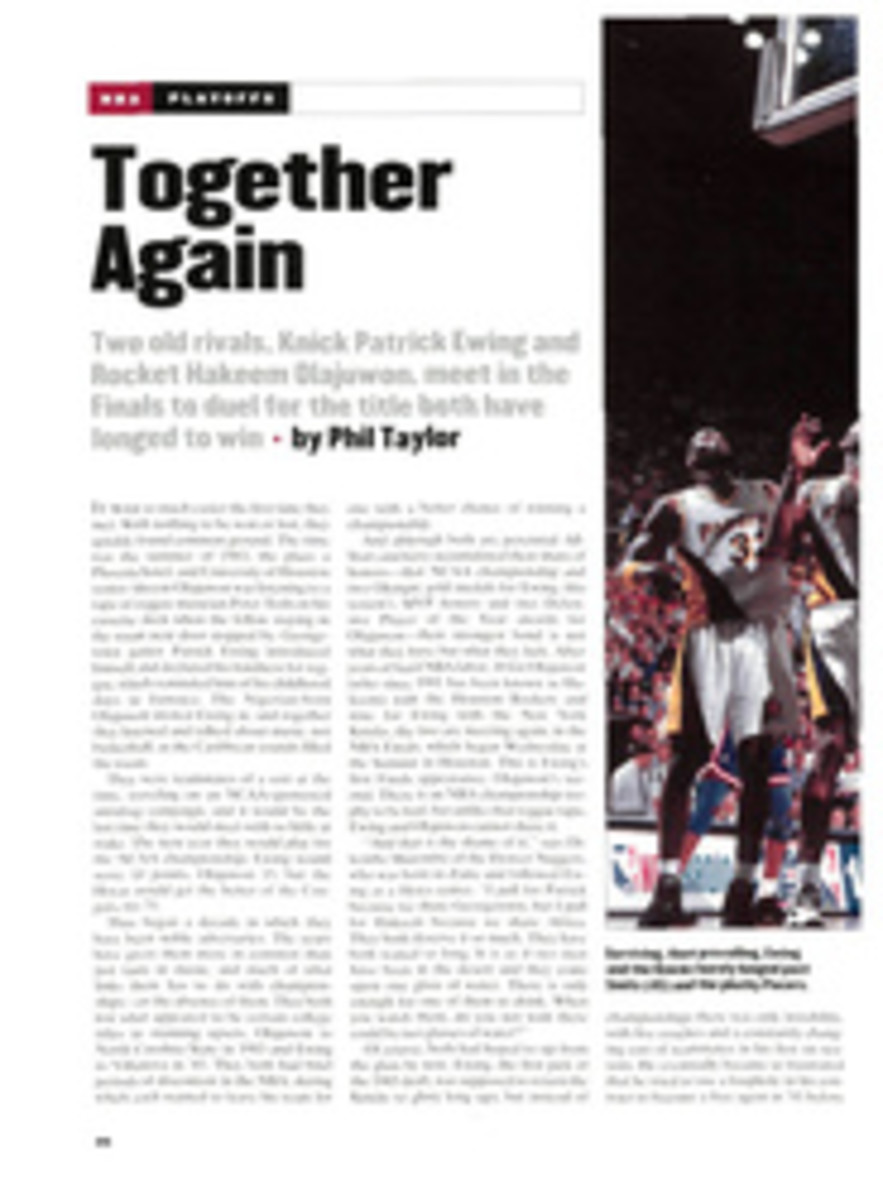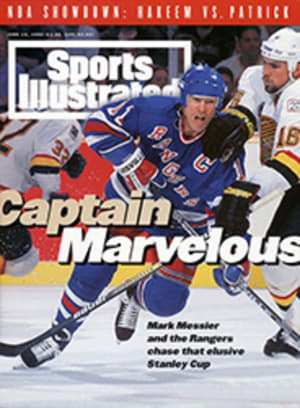
Dear Mom, Send Ben-Gay
Five days after stepping into a sculling boat for the first time, I was a mile into the two-mile Head of the Hosmer Race—on Great Hosmer Pond, beside the village of Craftsbury Common, Vt.—and in a state of nautical bliss. It was an early Friday morning. Mist was rising off the summer-warmed water, the air was spiced with the scent of woodsmoke, and the strokes I had been practicing all week were carrying me along at a brisk clip. As I pulled and feathered the oars, I was all but singing an ecstatic chorus of Row, Row, Row Your Boat. Suddenly a notorious Hosmer "crab"—the bane of all scullers, particularly of smug novices—grabbed hold of my right oar and shook my boat to an ignominious halt. Because scullers row with their backs to their destinations, the horizon, previously populated only by five young ducks, was immediately dense with my Craftsbury Sculling Camp classmates, all gaining on me.
In a Head of the Hosmer some years back, an oarsman fended off one of his competitors by hurling a dead fish into his boat. That was an effective maneuver but not one that my coach, Jamie Gordon, encouraged. Rather than pelt the competition with reeking refuse, Jamie preferred that his students row like crazy, and that is what I did.
There are any number of activities at the Craftsbury Center Sports Resort. In summer, distance runners attend a camp whose counselors have included such luminaries of the sport as Joan Benoit Samuelson, Judi St. Hilaire and John Dimick. There is riding and fly-fishing instruction and, for mountain bikers, more than 200 miles of dirt roads with nobody on them. Walking camps offer everything from casual jaunts with naturalists through cool Vermont forests to stride-for-stride race-walking instruction from Howard (Jake) Jacobson, coach of several Olympians. Huge segments of pasture, lake, wood and road are available in the summer for orienteering—racing over a course using only a map and compass—and in the winter for the Craftsbury Nordic Ski Center. Yet with all these sporting options, Craftsbury is best known for its sculling camp.
I had never before rowed anything but a canoe. But I had watched Olympic rowers on television; read David Halberstam's book about four intense oarsmen, The Amateurs; seen Thomas Eakins's paintings of scullers in New York and Philadelphia museums; and watched enough men and women in slim crafts zipping up and down lakes and rivers to be eager to try it myself. So for my summer vacation I packed plenty of extra clothing and a bag full of paperbacks and drove north through the Green Mountains.
Twenty-two years ago Russell Spring, a former downhill ski instructor and forest-fire spotter, decided to set out from his home in Moscow, Vt., to the Canadian province of Alberta, where he had vague hopes, he says, of becoming "a pioneer." He spent only a few days there before returning to Vermont, where he bought property in Craftsbury, a 200-year-old village with three churches, two general stores and two pristine lakes. Just above the smaller one, Great Hosmer Pond, was a group of empty buildings that had once been a boys' boarding school. Spring, who had done some rowing in college and loved it, took a look at the lake and decided to write to a number of college rowing coaches proposing that he turn the abandoned school into a rowing camp.
Since 1977 respected names in rowing—including Jim Joy, a former Canadian national team coach; Jim Barker, a former coach of Olympians; and accomplished rowers such as U.S. Olympians Garlic and Judy Geer and 1991 to '93 U.S. national team member Linda Muri—have been going to Craftsbury when the weather turns warm to teach the art of sculling to men and women aged nine to 79.
A sculling shell is a light, narrow vessel that is sensitive to ungainly movements. The first thing that I and the seven other, campers did the week we were in Craftsbury was to overturn our boats. This was part of the mandatory Hip test, which would ensure that if any of us suddenly found himself thrashing in the water alongside his boat, he would be able to clamber back in. One year a camper lost his dentures during this exercise, but all I parted with that first day was my dignity. The afternoon was row versus wade for me, and by dinnertime my teeth were chattering, my nose was dripping, and instructor Norm Graf, a former coach at Yale and Trinity College, had asked me, "Have you had a physical lately?"
Meals at Craftsbury rely heavily on fruits and vegetables from the chef's garden, freshly baked bread, locally tapped maple syrup, and apples picked in nearby orchards—all in unlimited quantities. Amid this tasty profusion, with a cup of tea at my elbow, I got to know my classmates. Perry, a 64-year-old oceanographer specializing in plankton, and his 61-year-old wife, Delores, had just been married and were spending their honeymoon with us. Christine, who has fire-enginered hair, is a member of a Delaware rowing club and a pharmacologist who has conducted experiments with depressed rats. John, a businessman from Santa Fe, N.Mex., was learning to row because his teenage son is a competitive oarsman and John wanted to share the sport with him. Jannik, a young Norwegian businessman with political ambitions who lives in Oslo, and Alec, who owns a shop in Lisbon that sells products featuring the Belgian comic-book hero Tintin, had both done a lot of sweep rowing (using a single oar) and wanted to learn to scull. A second man named John, a gregarious civil engineer in his mid-40's from Waterford, Ireland, was the only one of us with much sculling experience. After learning the sport at Craftsbury four years earlier, he had been competing in his single on rivers in Ireland, with considerable success. From the start we all liked each other very much, as we did Jamie, our principal coach, a member of the Yale varsity heavyweight crew that won the national collegiate rowing championship in 1982.
We convened each day at 7 a.m. for a dockside lecture on the components of the rowing stroke, from gripping and feathering the oar to releasing, catching, driving, steering and balance. There was another session after breakfast, at 10:30, and a third at 3:30 in the afternoon. By the second afternoon I had become entangled in tree branches along the shore, had plowed into a dock and had fallen into the drink twice more. "You're getting to be Olympic at getting back into a boat," Perry told me.
On the third afternoon we took a field trip instead of rowing, and my sore neck and blistered hands welcomed the respite. We went first to see the Concept II factory, where the best-selling rowing oars in the U.S. and the stationary rowing machines are designed and manufactured. Then it was on to another of Vermont's small-business successes, the Ben & Jerry's ice-cream factory in Waterbury.
By Wednesday, the fourth day of camp, I could make it all the way across Hosmer and back in one session, and I had gained enough confidence so that while concentrating on keeping my arms straight as I pulled, relaxing my shoulders and leading the drive with my legs, I could also do some looking around. Hosmer is a quiet lake, and birds are always alighting on it from the fir, maple and cedar trees on the shores, as are children, who swing into the water from ropes attached to tree limbs. Sculling, it seemed to me, is an ideal sport for daydreamers.
While we rowed each day, Jamie would course up and down the lake in a small motorboat, pausing beside each of us to comment on our strokes. On Thursday afternoon he lined up Alec, Irish John, Jannik and me at the far end of the lake for "some pieces." We rowed 10 strokes as fast as we could and then glided; then it was 20 strokes and a rest, then all-out for a minute, and so on. Hosmer looked like a glimmerglass that afternoon, and by dusk I had rowed on it for 15 miles. I wasn't the only one catching on. Jamie videotaped us that day from his launch, and that night, as we watched ourselves, it was clear that Craftsbury knew what it was doing.
At seven on Friday morning we all rowed two miles to the end of the lake, turned our boats and, in a staggered start, set off in the reverse of Jamie's predicted order of finish. Hosmer was calm and clear, and I started fifth, just before Jannik, Alec and Irish John, who had been warming up on the water since six and who was now cheerfully informing us that we all "rowed like buffaloes." Jamie started Jannik several hundred yards behind me, and for that first mile he stayed there. Then I caught my first crab. It is difficult to row like crazy with a form as rough as mine, but the sight of Jannik, John and Alec closing in on me was good incentive. Unfortunately, my steering had me progressing at wildly oblique angles, and the crabs weren't cooperating either. Twice more my oars caught in the water, and my boat seized up. Irish John flew past, and so did Alec. Jannik nearly overtook me as well, but, unaccountably, he stopped 10 yards from the finish line, thinking that he had already reached it. That was poor luck for him, but not quite as bad as New Mexico John's experience; he capsized five strokes from the end.
After breakfast there was an awards ceremony for which we each placed a mystery gift on a table to serve as a prize. I had finished the two miles in 15:18, good enough for fourth, behind Jannik, who resumed rowing once he realized his mistake, Alec and Irish John, who had churned through in 13:03 and now received a large can of Vermont maple syrup from Jamie as the regatta winner, in addition to his mystery gift, a Tintin T-shirt that Alec had brought from Portugal. As for me, I came away with a Concept II T-shirt—not a bad token by which to remember the most enjoyable week of my summer.
Craftsbury Sculling Camps run from late May through early October. Telephone 802-586-7767 or 800-729-7751.
PHOTO
DAMIAN STROHMEYER
By week's end camper Marilyn Chute kept dry except when near coach Peter Olrich's pal Kiev.
PHOTO
CRAFTSBURY ROWING CENTER
Camp chow is leaner than the rich fare of neighbors Ben & Jerry.

